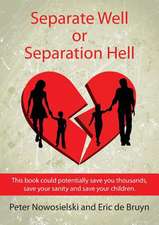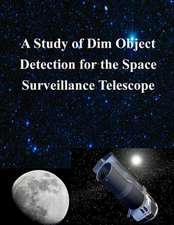Space Debris Peril: Pathways to Opportunities
Editat de Matteo Madi, Olga Sokolovaen Limba Engleză Paperback – 30 mai 2022
–Prof. Shinichi Nakasuka, University of Tokyo, Japan
Space Debris Peril: Pathways to Opportunities takes readers through the wide spectrum of problems created by space debris – including technical, political, legal and socio-economical aspects – and suggests ways to mitigate its negative consequences and create new opportunities. With chapter contributions from authors at world-renowned universities, private or public entities, and research institutes active in the field of space debris mitigation, space policy and law, risk and resilience, liability and insurance, this book provides a comprehensive introduction to the subject helping the reader to grasp the whole picture of the current space debris remediation challenges.
This book will be of interest to the scientific communities, policy makers, business developers, (re)insurers and international standards developers for space operations and orbital debris mitigation. Also, it should appeal to a broader audience among non-specialists in various sectors and the general public.
Key features:
- Brings together interdisciplinary perspectives on the topic in one, cohesive book
- Chapter contributions from specialists in this interdisciplinary field from around the globe
- Up-to-date information with the latest developments
| Toate formatele și edițiile | Preț | Express |
|---|---|---|
| Paperback (1) | 466.07 lei 6-8 săpt. | |
| CRC Press – 30 mai 2022 | 466.07 lei 6-8 săpt. | |
| Hardback (1) | 896.89 lei 6-8 săpt. | |
| CRC Press – 11 noi 2020 | 896.89 lei 6-8 săpt. |
Preț: 466.07 lei
Nou
Puncte Express: 699
Preț estimativ în valută:
89.18€ • 97.18$ • 75.15£
89.18€ • 97.18$ • 75.15£
Carte tipărită la comandă
Livrare economică 23 aprilie-07 mai
Preluare comenzi: 021 569.72.76
Specificații
ISBN-13: 9780367518196
ISBN-10: 0367518198
Pagini: 266
Ilustrații: 7 Tables, black and white; 31 Line drawings, black and white; 24 Halftones, black and white; 55 Illustrations, black and white
Dimensiuni: 156 x 234 x 14 mm
Greutate: 0.38 kg
Ediția:1
Editura: CRC Press
Colecția CRC Press
ISBN-10: 0367518198
Pagini: 266
Ilustrații: 7 Tables, black and white; 31 Line drawings, black and white; 24 Halftones, black and white; 55 Illustrations, black and white
Dimensiuni: 156 x 234 x 14 mm
Greutate: 0.38 kg
Ediția:1
Editura: CRC Press
Colecția CRC Press
Cuprins
1. Introduction. 2. Space Situational Awareness & Space Traffic Management. 3.Space Debris Sustainability: Understanding and Engaging Outer Space Environments 4. Overview of the Proposals for Space Debris De/ReOrbiting from the Most Populated Orbits 5. Space Debris Mitigation based on Commercial Off-the shelf Technologies. 6. Addressing the Inevitable: Legal and Policy Issues related to Space Debris Mitigation and Remediation. 7. Risk Assesment of Space Activities in Light of Space Debris Issues. 8. The Space Sector Resilience and Paths to its Governance. 9. Pathways to Opportunities.
Notă biografică
Matteo Madi, Ph.D., is an entrepreneur, business developer and space-tech specialist with over ten years of experiences in the Swiss and International public and private sectors. He is the founder of Sirin Orbital Systems AG based in Zürich, Switzerland, focused on the development of enabling technologies for On-Orbit Servicing (OOS) of satellites.
Olga Sokolova, Ph.D., is a risk analyst proficient in critical infrastructure risk assessment to natural and technical hazards. She has been engaged in development and analysis of structural risk-management tools towards sustainable future and has a record in raising social awareness of spaceborne risks and opportunities brought to the society by the "New Space" industry developments.
Olga Sokolova, Ph.D., is a risk analyst proficient in critical infrastructure risk assessment to natural and technical hazards. She has been engaged in development and analysis of structural risk-management tools towards sustainable future and has a record in raising social awareness of spaceborne risks and opportunities brought to the society by the "New Space" industry developments.
Recenzii
The Space Debris Peril by Matteo Madi and Olga Sokolova represents an outstanding review and analysis of the growing problem with low Earth orbit space debri. It provides an comprehensive overview of current effort to develop space traffic management techniques and improved space situational awareness processes to cope with this problem. I recommend this book at the very highest level.
Joseph N. Pelton, Senior Editor, Journal of Space Safety Engineering and Dean Emeritus, International Space University
The breath-taking growth of operational objects is leading to an increase of the space debris population that will come out of control, unless effective measures are taken, immediately! The book Space Debris Peril: Pathways to Opportunities, combines thoughts of specialists of diverse disciplines on solutions to this problem. The book looks in depth into the space traffic coordination and management and proposes different technical and organizational approaches, also relating to the deployment of large satellite constellations. It introduces the reader to engineering solutions for the removal of space debris from valuable orbits, presents affordable financial and technical methods to deter the growth of the number of space debris objects and addresses how the insurance landscape may adapt to these activities. These contributions can serve institutions as a helpful guide to implement infrastructure for space traffic, to create awareness of engaged personnel, and to mitigate and remediate space debris. The current situation urgently requires such measures to avoid losing the vital orbital regions of our planet.
Dr. Martha Mejía-Kaiser, Member of the Board of Directors, International Institute of Space Law
The questions of "how big is the space debris problem? What are we doing to keep it under control?" are some of the most frequently asked questions by the general public and the younger generations when they meet a professional working in the space sector. Reading this book has given me a comprehensive description of the problem, the risks and possible solutions from a multidisciplinary perspective by recognised specialists. I am now much better prepared to answer those questions and to give advice to our students and alumni who are learning or looking into research or business opportunities.
A highly recommended reference book for anyone in the space industry and anyone who cares about the sustainability of human activity in space.
Juan de Dalmau, President, International Space University - ISU
Space debris is a complicated problem. It is necessary to examine wide matters such as technology, policy, international coordination systems, legal aspects, commercial activities, risk and insurance etc. This book gives an overall general suggestion of these matters. It is an excellent book to provide a big picture of the issue of debris.
Particularly, the chapters on debris and the relationship with SSA (Space Situational Awareness)/ STM( Space Traffic Management) are interesting. Furthermore, debris will have a big influence on future space activities. This book will be useful for grasping the foundations for further discussion.
Jun Gomi, Associate Director General for Space Exploration, Japan Aerospace Exploration Agency
This brief book successfully explores the complex issue of space debris (and related topics such as space situational awareness and space traffic management) from a wide variety of lenses and perspectives, each of which is necessary to really understand the complexity of the issue. Technical chapters are followed by chapters by experts in the social sciences such as law and policy, and these perspectives and lenses compliment each other and result in creating a truly interdisciplinary and holistic understanding of space debris – already a complex and urgent problem that may yet get worse without focused attention and action. Chapters run the gamut from technical explanations of space domain awareness and how to remove large debris, to discussions of the space debris problem from international and national legal perspectives, insurance perspectives, and what approaches from science and technology policy studies can do to assist discussing and deliberating the space debris issue amongst all stakeholders.
Prof. Christopher D. Johnson, Secure World Foundation, Washington DC
"This latest contribution is a collection of presentations by a dozen authors, including engineers and lawyers, edited by a space entrepreneur and a risk analyst. The book gets straight into two of the subject’s leading buzz-phrases – space situational awareness and space traffic management - before taking a sidestep into the social sciences with a brief examination of "sociotechnical" and "sustainability" issues. The two following sections review possible deorbiting systems and other aspects under the currently fashionable headings of space debris mitigation and Active Debris Removal (ADR).
The volume ends with sections on space law, risk assessment and mitigation (including insurance) and space governance aspects. Most chapters end with a list of acronyms, a glossary, further reading and a bibliography, which makes the book a ‘compact primer’ for anyone new to the subject…The book serves to collect the relevant content together and present it in an academic context. This sets it apart from the many books that have sought to highlight the problem of space debris but trivialised it in the process (for example, by referring to it as ‘space junk’). To some extent, it is over-academised, which risks excluding the non-specialist element of its intended audience, but I know which approach I’d vote for if I was living on a space station in low Earth orbit!"
Mark Williamson, Space Technology Consultant, in ROOM Space Journal (2021)
Joseph N. Pelton, Senior Editor, Journal of Space Safety Engineering and Dean Emeritus, International Space University
The breath-taking growth of operational objects is leading to an increase of the space debris population that will come out of control, unless effective measures are taken, immediately! The book Space Debris Peril: Pathways to Opportunities, combines thoughts of specialists of diverse disciplines on solutions to this problem. The book looks in depth into the space traffic coordination and management and proposes different technical and organizational approaches, also relating to the deployment of large satellite constellations. It introduces the reader to engineering solutions for the removal of space debris from valuable orbits, presents affordable financial and technical methods to deter the growth of the number of space debris objects and addresses how the insurance landscape may adapt to these activities. These contributions can serve institutions as a helpful guide to implement infrastructure for space traffic, to create awareness of engaged personnel, and to mitigate and remediate space debris. The current situation urgently requires such measures to avoid losing the vital orbital regions of our planet.
Dr. Martha Mejía-Kaiser, Member of the Board of Directors, International Institute of Space Law
The questions of "how big is the space debris problem? What are we doing to keep it under control?" are some of the most frequently asked questions by the general public and the younger generations when they meet a professional working in the space sector. Reading this book has given me a comprehensive description of the problem, the risks and possible solutions from a multidisciplinary perspective by recognised specialists. I am now much better prepared to answer those questions and to give advice to our students and alumni who are learning or looking into research or business opportunities.
A highly recommended reference book for anyone in the space industry and anyone who cares about the sustainability of human activity in space.
Juan de Dalmau, President, International Space University - ISU
Space debris is a complicated problem. It is necessary to examine wide matters such as technology, policy, international coordination systems, legal aspects, commercial activities, risk and insurance etc. This book gives an overall general suggestion of these matters. It is an excellent book to provide a big picture of the issue of debris.
Particularly, the chapters on debris and the relationship with SSA (Space Situational Awareness)/ STM( Space Traffic Management) are interesting. Furthermore, debris will have a big influence on future space activities. This book will be useful for grasping the foundations for further discussion.
Jun Gomi, Associate Director General for Space Exploration, Japan Aerospace Exploration Agency
This brief book successfully explores the complex issue of space debris (and related topics such as space situational awareness and space traffic management) from a wide variety of lenses and perspectives, each of which is necessary to really understand the complexity of the issue. Technical chapters are followed by chapters by experts in the social sciences such as law and policy, and these perspectives and lenses compliment each other and result in creating a truly interdisciplinary and holistic understanding of space debris – already a complex and urgent problem that may yet get worse without focused attention and action. Chapters run the gamut from technical explanations of space domain awareness and how to remove large debris, to discussions of the space debris problem from international and national legal perspectives, insurance perspectives, and what approaches from science and technology policy studies can do to assist discussing and deliberating the space debris issue amongst all stakeholders.
Prof. Christopher D. Johnson, Secure World Foundation, Washington DC
"This latest contribution is a collection of presentations by a dozen authors, including engineers and lawyers, edited by a space entrepreneur and a risk analyst. The book gets straight into two of the subject’s leading buzz-phrases – space situational awareness and space traffic management - before taking a sidestep into the social sciences with a brief examination of "sociotechnical" and "sustainability" issues. The two following sections review possible deorbiting systems and other aspects under the currently fashionable headings of space debris mitigation and Active Debris Removal (ADR).
The volume ends with sections on space law, risk assessment and mitigation (including insurance) and space governance aspects. Most chapters end with a list of acronyms, a glossary, further reading and a bibliography, which makes the book a ‘compact primer’ for anyone new to the subject…The book serves to collect the relevant content together and present it in an academic context. This sets it apart from the many books that have sought to highlight the problem of space debris but trivialised it in the process (for example, by referring to it as ‘space junk’). To some extent, it is over-academised, which risks excluding the non-specialist element of its intended audience, but I know which approach I’d vote for if I was living on a space station in low Earth orbit!"
Mark Williamson, Space Technology Consultant, in ROOM Space Journal (2021)
Descriere
Space Debris Peril: Pathways to Opportunities takes readers through the whole spectrum of space debris problem – from technical, political, legal and socio-economical aspects – and represents an attempt to describe this credible risk and ways to mitigate its negative consequences, and create new opportunities.













